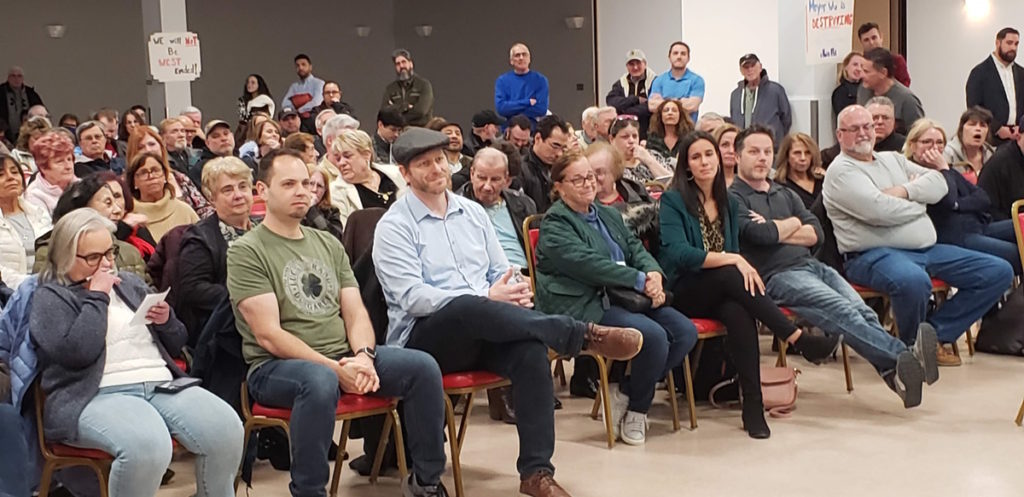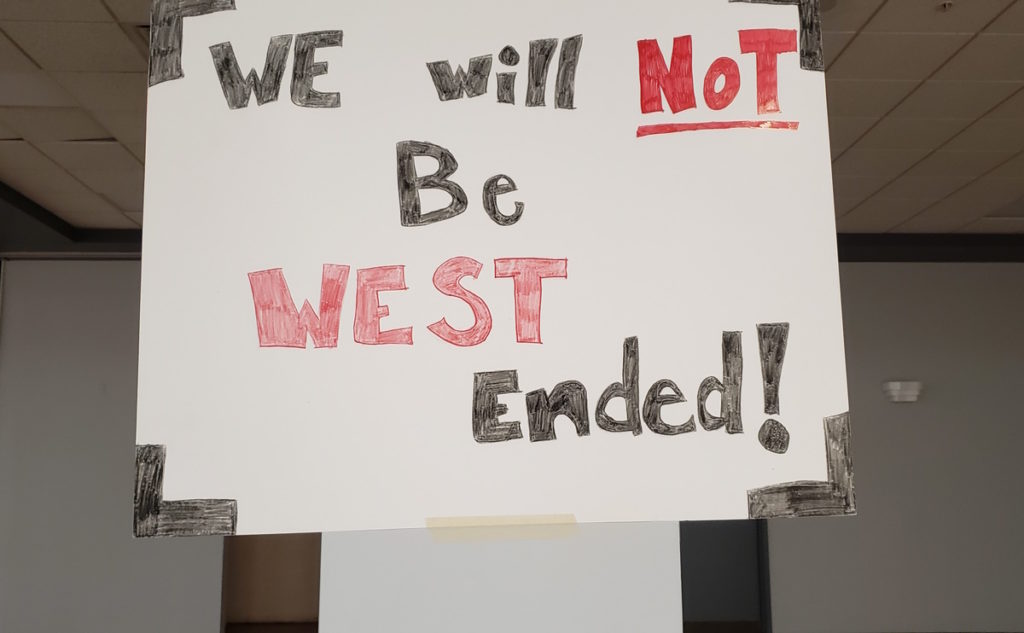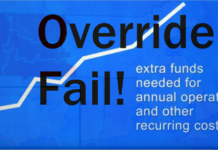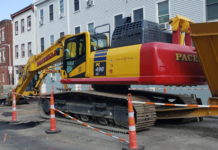By Mike Freedberg
SPECIAL TO EASTBOSTON.COM
About 250 residents, the overwhelming majority from Orient Heights, assembled in the Don Orione auditorium on Wednesday, March 22, 2023 to hear city planners detail the latest iteration of their “up zoning” plan for the venerable neighborhood.
The audience was reminded that the host location was a church, but the audience was not in a solemn mood.
The mood was at best skeptical, more often downright angry. As State Senator Lydia Edwards — who has come to attend almost everything in her mostly wage-earner District — said to the City people, “there isn’t a whole lot of trust.”
No, there isn’t.
Several speakers from the gathering made clear that they don’t believe City Hall will keep its promises — a few were offered, more about them later — and that in any case, the “Planning and Redevelopment Agency,” which hosted the meeting, is not the Zoning Board of Appeal, which grants the variances that shovel whole neighborhoods into dust, often overriding denials by the “BPDA.” Thus, the short supply of residents’ trust. After all, Orient Heights has already seen plenty of big-box development compromising its single-family home culture.
That said, the City’s BPDA chief, Arthur Jemison, did come and did face the voters. He had an offer to make. As he put it, “we’re no longer
talking four, five, six units. We have heard you. In most of Orient Heights zoning will be limited to two family buildings.”
This sounded like a potential deal; yet there was, perhaps inevitably, an out. An owner occupant, said Jemison, would be allowed to build a
third unit, an “ADU” – attached dwelling unit” — a kind of mother-in-law apartment small in size.
The voters didn’t like that at all. Someone in the audience asked “So an owner-occupant gets to build a third unit? What’s to prevent him from selling his three units two years later to an investor?”
Jemison ducked. “We don’t think most people will do that.”
The audience of 250 laughed at him. “They already do it,” some said.
From there, residents unleashed their full plate of development grievances: and East Boston has a flood of such grievances, from traffic
to loss of parking spaces to big box ugly condos, the Blue Line, airport expansion, pollution, you name it — going back 60 years almost without reprieve.

But back to the Heights issue. The Heights is, at its core, a single family zone. Single-family homes with lawns and garages, a style of
living rare in East Boston and under serious attack by climate activists who want to phase out such homes, with their car-centered custom, in favor of high density, transit-oriented blocks with no allocation for parking cars. Heights residents aren’t having it : as Mary Berninger, a
dedicated neighborhood-activist, noted, “People who have invested time and money in their properties are entitled to an expectation that their neighborhood will not lose its style, that the value of their homes will not be taken away.”
Or, as City Councilor Erin Murphy put it in her speech at the meeting, “Neighborhoods in Boston are very different. They have a right to be
different.”
This degree of difference presupposes a very local self-determination, which fits Orient Heights’ three (voting) precincts but flies in the face of climate and density priorities that planners are applying to the entire City. After all, what is “up zoning” but an external imposition, of increases in occupancy, on a neighborhood that is so very different from how the City as a whole looks today?
John Cass, an owner of a fine single-family home, isn’t buying the two-family compromise. He says, fine, two family — but how big will the
footprint of it be? At the meeting he noted that the “up zoning” proposal allows owners to build in 40 percent of his lot, up from 30
percent, which adds to the density that worries him and his neighbors
Cass also explained he opposes the plan’s 2000-3000 square feet per floor of buildable room in the “compromise” plan.
“These houses could be huge,” he said. “Nine thousand square feet?
Jemison did not even try to rebut Cass.
As for parking, nothing is being required.
(I leave for another day the prospect that all this upping by the City on a plan bruited in 2019 is no longer needed, the housing panic having
abated significantly.)
Can Orient Heights’ very small community get the City to back off? To allow it to be “different,” as Councilor Murphy put it?

Or, as resident-homeowner-activist Gail Miller said, “East Boston has done more than its share of density. It’s time for other neighborhoods
to do their part.” We’ll see.
If Mayor Wu is ready to come face to face with the Heights community, perhaps there’s room for an accommodation. Yet how does she respond to young homeowner Fatima Litiim, who talked about her good fortune in being able to buy a home in East Boston only to find that prices now have risen so far out of whack that she no longer recognizes the immigrant-rich neighborhood into which she as born ? Litim spoke eloquently at length. “The notion of family is in jeopardy. This plan feels like a war on family. How do you raise a family in a 2-bedroom condo that you can barely afford? You don’t.”
As for Mayor Wu, perhaps he is feeling some embarrassment at having attended Eastie Farm’s Spring Equinox Celebration ( a lower-key safe-space gathering politically) on the morning of the Orient Heights meeting of 250 people, that she did not attend. Embarrassed enough that she now wants to face the inevitable dislike that almost certainly will be expressed to her face.
(Note: the Chelsea Street location of Eastie farm’s greenhouse, in the Flats section of East Boston, is no less affected by the Zoning Board’s granting of variances or the long-range plans of the BPDA than is Orient Heights So-called luxury housing is certainly also out of place there)
Joe Arangio, who guided the audience with his own interpretation of the BPDA plans, brilliantly summed up the purpose of the zoning code and its meaning. “What’s the fabric of Orient Heights? That’s fundamentally what we are talking about here,” he said.
Only seven buildings in a specific area of the Heights, mostly around Don Orione, are three families; the majority, 95 percent, said Arangio are much smaller structures. Much of the same could be said for the Bayswater section of Orient Heights, he noted.
Arangio added, “The point I’m trying to make here is that this community is about single family and two family and let’s not get diverted by the three-family aberrations.”
The consensus is that less than radical changes are needed. The existing zoning code is sufficient according to residents. The problem is the overwhelming clout of developers are able to secure variances at the rate of 95 percent. Other details such as the lack of traditional set-backs found in existing housing but jettisoned in the approvals of the new housing drew much criticism from Orient Heights. Another problem is that the rush to develop “luxury” housing is totally misplaced and is hardly a solution to the city’s housing crisis.
Joe Steffano, a resident and activist involved with Stand Up Eastie asked a simple question: “Why won’t they at least listen?”
By “they,” of course, he means Mayor Wu.
— Mike Freedberg
Mike Freedberg is editor and publisher of the blog, Here and Sphere. He is also a political consultant. He regularly contributes original, participatory content to EastBoston.com.

Originally posted March 25, 2023
















